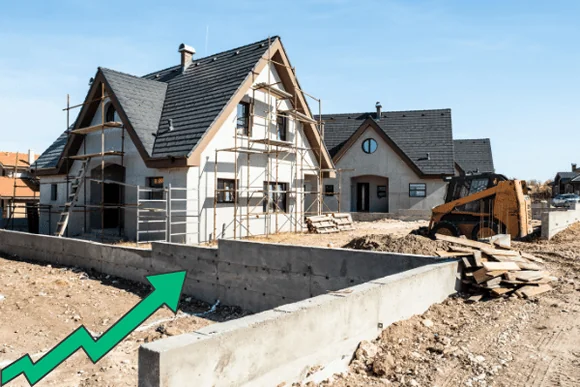Bridging Trends Data Shows Bridging Finance Lending Returning to Levels Last Seen in 2018
The latest data released by Bridging Trends shows that the third quarter of this year has seen the highest volume of bridging lending since 2018, reaching over £190 million.
This is a massive jump from the previous figure of £146 million recorded in the second quarter of 2021 and a 65% increase when compared to last year (£115.52 million).
It is thought that the reason for this increase can be mainly attributed to the strong property market seen before the stamp duty holiday was tapered and ultimately stopped.
The most popular use of bridging finance for the second consecutive quarter was for the purchase of property, with 28% of total contributor transactions (up from 24%), followed by a lower figure of 13% for chain break (down from 20% in the previous quarter).
There was also a surge in demand for auction finance, from 4% in Q2 to 11% in Q3.
First-charge bridging loan finance, which accounted for 90% of the total market volume, remains unchanged.
There was, however, a drop in regulated bridging loan transactions for the fifth consecutive time, with figures falling from 41.6% in quarter 2 to 37.7% in quarter 3.
The data released also showed an increase in average LTV from 54.9% in Q2 to 60.2% in Q3, this being the highest since the launch of Bridging Tends in 2015. This rise indicates that borrowers are taking advantage of liquidity opportunities and the low rates available to them.
Co-founder of Adapt Finance, Stephen Burns, commented: “The most exciting part to read is ‘returns to’ when referring to activity levels.”
“It shows the industry was affected by the disruption the coronavirus pandemic put the country through, but more so, how it has pulled back quickly, and we are now firing on all cylinders!”
Managing director at Impact Specialist Finance, Dale Jannels, added: “These figures show that bridging finance is now a better-understood product for many brokers, and they have much more confidence in recommending this solution to their customers.”
“The stamp duty holiday allows bridging finance to be more widely accepted by the mainstream industry as a need to meet speed demands, but investors with the intention to renovate have also been at the forefront of recent requests.”
Director at LDN Finance, Chris Oatway, stated his surprise that the LTV was as low as 60% on average, stating that they had seen an increased demand for higher leverage deals at 70%–75% LTV.
“Regulated transactions accounting for over a third of the market stand out when you consider the limited number of bridging lenders who are able to transact regulated business and show there’s opportunity there for more lenders to enter this market,” he added.
Head of specialist lending at Enness Global, Chris Whitney, said: “With the news that contributor gross bridging loans are over £190 million, it makes me wonder how big this market really is in its entirety.
LTVs are up, with borrowers possibly taking advantage of increasingly cheaper money in the light of reports that mortgage rates, in general, are heading upward imminently.
However, with continuing competition and even more new entrants in the short-term lending space, it will be interesting to see how that pans out with so many lenders looking to increase market share in a seemingly very liquid environment.”
“At 60% LTV, I think we are still seeing prudent levels of borrowing by people and responsible lending from the funders.”
He also added that he wasn’t at all shocked by the increase in processing times, stating that it would be a direct result of increased volumes, valuers being stretched, and lenders finding it difficult to recruit good underwriting.
“With the highest use of funds being for investment purchases, I think it really shows how much confidence people have in UK real estate.”
Home Loan vs. Mortgage: What’s the Difference?
Home loans and mortgages are almost always interpreted as the same thing.
You could argue that a mortgage is a type of home loan, given that it is a loan used to purchase a home. There are significant differences between the two in terms of their functions and intended applications.
A home loan is more restrictive with regard to how the funds can be used; a home loan can exclusively be used to cover the costs of buying or constructing a home. Conversely, a mortgage can be used for absolutely any purpose if the applicant meets the required criteria for the loan.
In addition, there are various different types of home loans that fall within the broader classification. Examples of this include commercial property loans, non-residential premises loans, construction loans, top-up home loans, home extension loans, home renovation loans, and so on.
Some types of home loans can be taken out alongside a mortgage as a means of funding a specific project. For example, you could take out a home extension loan to cover the costs of an extension. However, it would be expressly forbidden for the funds to be used for any other purpose. If you were to extend your current mortgage to generate capital, it could be used for any legal purpose.
The main differences between home loans and mortgage loans
To help clarify the confusion, what follows is a concise summary of the main properties of the two types of loans and how they differ:
Home loans
- A home loan is typically issued exclusively for the purchase or construction of a home and cannot be used for any other purpose.
- Home loans are typically issued with a comparatively high LTV, often covering as much as 90% of the property’s purchase or construction costs.
- Cost-effectiveness varies significantly from one lender to the next; interest rates on home loans can be lower than those of a conventional mortgage.
- Borrowing costs can also differ significantly between lenders, typically including an initial processing fee of 0.8% to 1.2% of the total value of the loan.
- Flexible repayment terms are available over the course of anything from 10 to 30 years, in accordance with the preference of the borrower.
Mortgage loans
- The main difference with a mortgage is that the funds can be used in any way the borrower likes. The loan is issued using their home as collateral in the same way, but there are fewer restrictions placed on how the money can be spent.
- A typical mortgage will be issued with an LTV of around 70% to 80% of the market value of the property. Some lenders have begun once again offering mortgages with an LTV of 90% or even 95% to those who meet the required criteria.
- There are major differences from one lender to the next, but the interest rate payable on a mortgage is usually around 1% to 3% higher than that of a comparable home loan.
- The same also applies to processing fees, which, with the typical mortgage, will be around 1.5% of the total value of the loan.
- With a mortgage, it is usually easier to extend the size of the loan and borrow more money should the initial amount be insufficient to cover all costs and requirements.
Whatever your objectives for the funds you need, it is important to seek independent broker support before applying. This will help you not only determine the most cost-effective option available but also get the best possible deal from an extensive panel of specialist lenders.
If you would like to learn more about the differences between mortgages and home loans, contact a member of the team today.
Bridging Loan Completions up a Further 23% in the Second Quarter
The latest figures from ASTL indicate strong quarterly performance for the bridging sector in Q2 this year; up an impressive 23.2%, total completions for the three-month period came out at £1.1 billion.
The high number of completions during this period meant that bridging loan books increased to more than £4.7bn, up from £4.4bn in the first quarter.
Commenting on the figures, ASTL CEO Vic Jannels said the increase in completions was reflective of a significant reduction in completions during the first quarter of the year, with the market having subsequently corrected itself.
Despite the higher number of completions and growth in overall market value, bridging finance applications were down in Q2 compared to Q1. Total application volumes were down 1.7% to reach a total of £7.36 billion.
Compared to the same period last year, total bridging applications at the end of June were up approximately 27% from 2020.
The outlook is therefore seen as generally positive for the sector, with around 90% of lenders saying they expect their businesses to grow over the remainder of the year.
Bridging loan default value down
ASTL’s figures also suggest that the total value of bridging loans in default is still on the decline since the start of the year. Compared to Q1, the value of bridging loans in default was down 7.6% in Q2.
Consequently, repossessions were also down over the past three months compared to the start of the year, indicating that the gradual return to normality after 18 months spent in lockdown could be having a positive effect.
ASTL also reported that the average bridging loan LTV currently stands at fewer than 60%, a fractional increase on the figure reported in Q1.
“The falling value of loans in default and the number of repossessions reflect the quality of lending and show that the market is continuing to grow sustainably and enhance its ever-improving reputation,” commented Vic.
“In this growing market, ASTL lenders continue to represent a benchmark of quality and customer focus, providing brokers with a source of flexible short-term finance that they can trust.”
FC Barcelona Saved from Bankruptcy by €595m Bridging Loan
FC Barcelona have rarely been out of the headlines over the past few months, primarily due to the sensational departure of Lionel Messi after a lifetime spent with the club.
The president of FC Barcelona, Joan Laporta, has spoken of the “very worrying” financial situation the club is currently in. Having revealed that Barcelona is now approximately €1.35bn (£1.15bn) in debt, he blamed what he referred to as a “terrible inheritance” on his predecessor, Josep Bartomeu.
He also highlighted Lionel Messi’s departure as a key factor in the “dramatic” situation Barcelona now faces, resulting in a Goldman Sachs bridging loan valued at €595 million being taken out to save the company from outright bankruptcy.
Laporta remains adamant that Bartomeu should be held accountable for the financial meltdown currently taking place behind the scenes.
His comments came at a recent press conference when he cited excessive salaries as one of the reasons behind the club’s unsustainable financial position.
“Our salaries represent 103 per cent of the club’s total income. That’s 20–25 per cent more than our competitors,” he said.
“The first thing we had to do when we arrived was to ask for a loan of €80 million because otherwise, we could not pay the salaries. The previous regime was full of lies.”
He also went on to blame his predecessor for leaving him with huge stadium repair and maintenance bills to cover, along with failing to be truthful about promised wage cuts.
“We also found that we had to do some urgent repairs to the Camp Nou because otherwise, it posed a risk to the attending fans. We also found out that the club had already received 50 per cent of the TV rights fees in advance.”
“We found the wage policy in the form of an inverted pyramid: veterans on long contracts and youngsters on short deals. There were no wage cuts.
“We have found that disproportionate payments have been made to intermediaries, not even agents.”
Speaking on behalf of Sky Sports News, Kaveh Solhekol warned that FC Barcelona is currently in a “terrible” financial situation, with no obvious way out for the time being.
“Barcelona has a negative net worth of €451 million; it is a terrible inheritance. What has been happening is very worrying,” he said.
“Bartomeu’s (open) letter is an effort to justify management that is unjustifiable. It is an exercise in desperation. They are responsible for everything until March 7. They will not escape their doing.”
Speaking on the future of the club, Laporta spoke confidently about Barcelona’s ability to resolve its financial troubles while confirming its receipt of a bridging loan worth “€550 million with an interest rate of 1.1 percent to restructure the club.”
“The situation is dramatic, but we have good news,” said Laporta.
“The strategic plan based on our credibility and experience and on the assets that Barcelona has makes this situation temporary. I think that in a couple of years, the club’s economy will be healthy.”
“We are not scared at all. We are highly motivated and positive, and morale is high. It’s a big challenge, but we are capable of overcoming it.”
“I’d like to call on all Barcelona fans and the entire club to be united. With football and unity, I’m convinced this era will be full of success.”
Bridging Finance for the Small Business: How Does it Work?
A bridging loan is essentially a short-term commercial loan secured against an appropriate property or asset. It is designed to be repaid within a matter of months; bridging finance can be uniquely cost-effective over the short term.
Another major point of appeal with bridging finance is the speed with which it can be arranged; typical loan completion times are no longer than two weeks, though it is often possible to access the funds required within just a few days.
This can make bridging loans an immensely useful and versatile product for smaller businesses that routinely encounter unexpected outgoings and cash flow shortages.
How does a bridging loan work?
Bridging finance works in almost exactly the same way as a typical secured loan; the funds are issued against an asset of value, typically the applicant’s home or a business premises, and are repayable by the borrower along with the agreed rate of interest.
What differentiates bridging finance from a typical secured loan is the short-term nature of the facility. Bridging finance is designed to be repaid within a few months in the form of a single lump-sum payment on an agreed date.
There are typically no monthly instalments for the duration of the loan, and the balance in its entirety is repaid in a single payment.
What can I use bridging finance for?
Bridging loans are also advantageous in that they can be used for any legal purpose whatsoever. If you have an asset of value your lender is willing to accept, the funds raised can be invested or allocated in any way you like.
Just a few of the most popular uses for bridging finance are as follows:
- Purchasing properties at auction at rock-bottom prices.
- Buying non-standard properties to refurbish or repurpose.
- Covering urgent outgoings or unexpected cash flow shortages.
- Investing in equipment and machinery for business purposes.
- Relocating to new premises or property expansions.
- Paying tax bills to avoid possible penalties.
In all of the above instances, bridging finance can be more convenient and cost-effective than any conventional loan. again, under the strict condition that the funds are repaid in a timely manner as agreed.
Who can qualify for bridging finance?
As with all loans, lending criteria vary significantly from one lender to the next.
As a general rule of thumb, you can expect the following verification checks as part of the application process:
- Proof of identity and residency.
- Evidence of a viable exit strategy (repayment plan).
- Formal valuation of your property.
- Proof of income and expenditure.
- Verification of current financial position.
- Full credit history check.
In spite of the above, it is worth remembering that many lenders issue bridging finance primarily on the basis of security. If the value of the property used to secure the loan vastly exceeds the total loan value, other verifications (like credit history checks) may not be necessary.
If you have any questions or concerns regarding your eligibility for bridging finance, ensure they are raised with your broker before applying. This will help ensure you target the right lenders with your application in order to secure an unbeatable deal.
Renovations Set to Get More Expensive as Building Material Costs Skyrocket
Property renovation and repair bills are expected to climb significantly over the coming months as builders warn of a major shortfall in the availability of even the most basic supplies. As a side effect of the UK’s booming housing market, builders are struggling to get hold of everything from roof tiles to timber to bags of concrete.
Many have likened it to entering a supermarket to find empty shelves, with the availability of building essentials having totally dried up in some regions. Rather than relying on a stockpile of products to allow projects to be completed, builders are increasingly buying what they need at the last minute, if and when the products they need are available.
As a result, there has already been an increase of around 10% in the costs of building materials, though those in shorter supply are becoming even more expensive. This means that homeowners considering property improvements or urgent repairs over the coming months can expect significantly higher costs as contractors look to augment the prices of building materials.
Seven months of price increases
Timber and steel prices in particular have reached highs not seen for some time, with the IHS Markit/CIPS UK survey having indicated no less than seven consecutive months of price increases to date.
According to Noble Francis, economics director at the Construction Products Association, steel and copper prices have increased by up to 40% over the past six months, while the average price for timber has increased by as much as 80% in some regions.
Even the most basic supplies like varnishes and paints are up to 30% more expensive than they were when compared to the previous year, while the price of polypropylene is up by 60%.
As the vast majority of all building materials used in the construction sector are produced domestically, manufacturers and suppliers have limited on-hand inventory to fall back on.
“You can’t point the finger at anybody because so many different materials have availability issues right now. People who have been in this industry for over 30 years say they’ve never seen anything like it,” commented John Newcomb, the chief executive of the Builders Merchants Federation (BMF).
Another COVID-19 casualty
Many builders and contractors are now facing the prospect of heavy delays in project completion times, with lead times for concrete having increased to as much as three months. Roofers in particular are expected to struggle for the foreseeable future, with raw material costs having increased by around 50% to date.
The issue has been caused by a variety of contributory factors, though it has been greatly exacerbated by the temporary closures of many factories, mills, and production facilities and throughout three consecutive lockdowns. While the government showed lenience with regard to requirements for the construction sector to cease operations, producers are still struggling to catch up with pent-up demand for materials and supplies.
“We’re fighting hand-to-mouth to make sure materials are getting through. It’s just that people have to wait longer, and, of course, raw material prices are going up, so they are having to pay more,” said Newcomb.
“The jobbing builder has traditionally gone into a merchant and said I want three of this and six of that; those days are gone.”
“The key thing is not to go in expecting you can turn up at the door and just take those materials away, because that is not going to happen.”
Essential Expert Advice for Fixer-Upper Property Purchases
Popular culture has played a major role in encouraging more people than ever before to try their hand at ‘flipping’ homes and commercial properties. Interest in the “fixer-upper” properties is at an all-time high, as younger demographics in particular set their sights on building their dream homes for cheap or turning a comparatively quick profit.
However, experts continue to stress that the risks associated with purchasing fixer-upper properties must not be underestimated. More specifically, potential buyers are being advised to follow five essential guidelines before committing to the purchase of a property for renovation.
Arrange a comprehensive survey
It is always advisable to organise a more intensive building survey than would normally be conducted. This will ensure that you gain detailed insights into the renovations, repairs, and improvements necessary to restore the property to an appropriate standard. In addition, a detailed building survey could provide you with useful information as a basis for negotiating a more competitive price.
Consider financial products in advance
Do not make the mistake of waiting until the last minute to consider the funding options available. This is because properties that are considered uninhabitable may exclude you from most conventional high-street mortgages. Specialist property loans for fixer-upper properties are available, but they often call for independent broker support to access them. Fully research the options available ahead of time in order to ensure you understand what is on offer, how much you will be expected to offer as a down payment, and so on.
Factor the price of the property against the repairs required
This may also call for specialist help, as it may be difficult to accurately calculate the total costs of the renovations required without an experienced surveyor or contractor. It is essential to come up with an accurate total figure for the renovations and improvements you intend to carry out in order to determine whether the property is worth purchasing at its current price.
Anticipate the prospect of exceeding your budget
Research suggests that close to half of all fixer-upper property projects result in their buyers exceeding their budgets. You should therefore ensure you have some kind of backup plan available in the event that you run short on money at the worst possible time. This could be something as simple as putting off less urgent renovations until a later date or considering a mortgage extension if available.
Consult with an independent broker you can trust
Lastly, involving a reputable independent broker at the earliest possible stage is highly recommended. Along with helping you find the most competitive loan to fund the project, a broker can provide you with the independent advice and support you need to make a safe and informed decision.
2020s Most Important Bridging Finance Trends
Bottom Line: The bridging sector saw a combined fall in lending of £278 million last year, but evidence suggests the market is bouncing back from the impact of three consecutive lockdowns.
Collective bridging transaction completions were down by £278 million last year.
The average LTV on bridging loan issues decreased to 50%.
Bridging loan interest rates fell to historic lows during the fourth quarter.
Regulated and unregulated loans occupied an equal share of the market.
The most common application for bridging finance in Q4 was chain breaking.
The economic fallout attributed to the first two national lockdowns had a major impact on the bridging finance sector last year. As a result, total transactions for 2020 were down by approximately 38% from the previous year, to £455 million compared to £732.7 million in 2019.
Decreases in bridging finance activity were particularly prominent during the first six months of 2020, when the UK’s real estate market was temporarily shut down in its entirety. In the first quarter, bridging loans valued at a total of just under £113 million were issued. By the end of Q2, this had plummeted to just £79.4 million as lockdown restrictions took effect.
However, reassuring signs of improvement were noted during the closing six months of the year. Total bridging finance activity in Q3 came out at £115.52 million, increasing further to £137.22 million in the fourth quarter.
The latest figures released by Bridging Trends highlight a series of key findings for 2020. Bucking the trend of previous years, there was almost no difference in the share of the market occupied by regulated and unregulated transactions in 2020. Regulated transactions accounted for 36% of the market in 2018 and 39% in 2019, last year climbing to an impressive 49.4%.
Average monthly interest rates also fell to record lows during Q4, averaging just 0.72%. This is more than a full percentage point lower than the 0.85% peak recorded in Q2, which was followed by a fall to 0.78% in the third quarter.
Evidence suggests that bridging finance specialists are continuing to distance themselves from high LTV products, with the average LTV on a bridging loan last year coming out at 50.7%, significantly lower than the 52.9% and 54.6% of 2019 and 2018, respectively. The lowest average LTV of all was recorded in Q2 at the height of lockdown, 48.8%.
23% of the bridging loans issued in 2020 were second-charge loans, presenting a sizeable uptick of 20% from the year before. Q2 in particular saw a major spike in second-charge bridging transactions, an all-time record high of 26.1%.
Primary applications for bridging loans changed little from previous years, with funding investment purchases once again topping the table for the year as a whole, accounting for 22% of all transactions. Interestingly, chain break overtook investment purchases in the fourth quarter, accounting for a full 23% of all bridging loans. Bridging finance for business purposes came out with an annual market share of 11%; heavy refurbishment also accounted for 11% of all transactions last year and 12% of the bridging loans we used for regulated refinance purposes.
On average, bridging loan completions took 50 days in 2020, slightly longer than the 47-day average in 2019.
The average loan term in 2020 was 12 months, the same as in 2019. The average completion time averaged 50 days, up from 47 days in 2019 and 45 days in 2018.
Gareth Lewis, commercial director at MT Finance, comments:
“After the first lockdown, we saw the re-emergence of some larger lenders, and if you combine this with the stamp duty changes, it is no surprise that there was a stimulus on rates and regulated bridging in the latter part of the year.”
“As the vaccine rolls out and we gradually emerge from this lockdown, I believe we will see a new transactional flow from renewed confidence in the economy and businesses re-establishing themselves.”
Dale Jannels, managing director at Impact Specialist Finance, comments:
“The impact of the pandemic on the bridging sector is shown clearly in Q4’s data, but it also alludes to the activity we are now experiencing, some of which, but not all, is related to the Stamp Duty Holiday deadline.”
“It’s clear though that bridging finance is becoming better understood by the wider broker market (not just those in the specialist sector), and there is more confidence about the options it can provide customers, which should mean that 2021 could see a real watershed moment for this type of finance.”
Kevin Blount, head of operations at Clever Lending, comments:
“We certainly had an increase in inquiries during Q2, which led to a spike in new business submitted to lenders in Q4. We are working hard with lenders to find solutions, who in turn are reviewing their criteria and interest rates to fit the current market.”
“The SDLT holiday helped to bring business to the bridging market, which is continuing into 2021.”
Chris Whitney, head of specialist lending at Enness, comments:
“I am actually quite surprised that the fall in lending quantum in 2020 was so large. The market has always ‘felt busy’ and Enness did not see such a big drop in lending volumes.”
“Yes, we did see some big names close their doors as the whole country was forced to work out their strategies in the face of the pandemic on a micro and macro scale, but some still aren’t back as they were. However, I think most of the short-term lending market either carried on throughout or paused only temporarily as working practices were refined and made fit for purpose under the restrictions we faced, as well as the level of uncertainty that still hangs over us.”
“The absence of some big names has reduced supply, coupled with some restricting LTVs, which has had a marked impact on lending levels. I think this is also reflected in the fall in average LTVs over the year.”
“However, as the trend in Q3 and Q4 indicated, I think we will see volumes bounce back quite quickly, and with people re-entering the market, the data is reflecting the stiff competition lenders face for business in terms of lower interest rates.”
“There are some big high-street names who see themselves as ‘business banks’ but I know from first-hand experience that many did not step up to the challenge and support their customers as they should at this time. Borrowers were turned away or faced a huge amount of red tape to navigate on their own, not being able to get the support they needed so badly in a timely manner.”
“I think this is reflected in the increase in second-charge loans and the increase in regulated loans as well. The mainstream high-street lenders made it very hard to increase current loans, and if they did, it was taking much longer than normal. Consequently, I think that is why we see ‘chain breaking’ high on the list for uses of bridge loans. Lots of borrowers use bridge loans as an essential tool on a regular basis, but I think we have seen an increase in new to the sector borrowers, which has contributed to a shift in some of the historic dynamics.”
“I think overall the short-term lending market can be proud of what it managed to achieve in unprecedented times. I know there are an awful lot of people who are very grateful, whose businesses, personal lives, and families are better for what the industry was able to offer them.”
“I am sure 2021 will have its challenges, but I feel our industry is ready to take on whatever is thrown at us.”




 0116 402 7982
0116 402 7982







